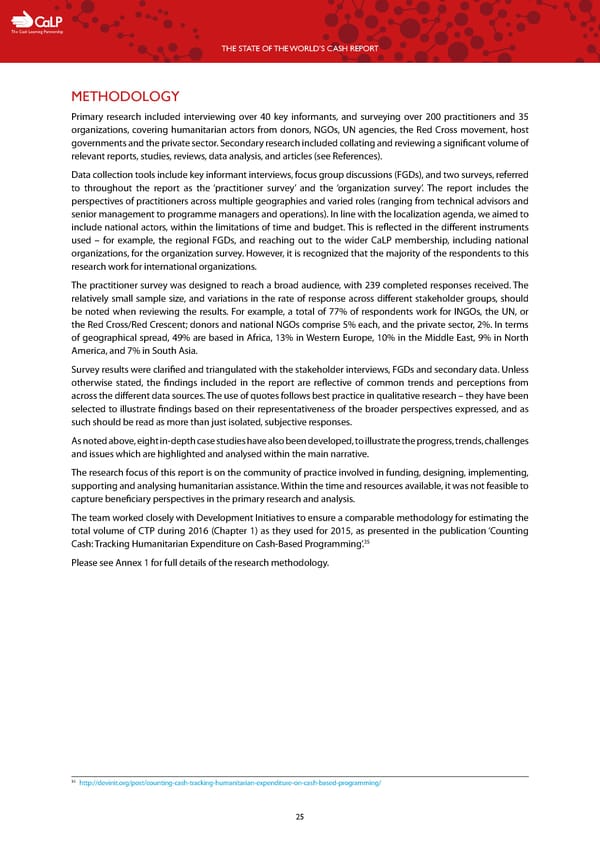C The Cash Learning Partnership THE STATE OF THE WORLD’S CASH REPORT METHODOLOGY Primary research included interviewing over 40 key informants, and surveying over 200 practitioners and 35 organizations, covering humanitarian actors from donors, NGOs, UN agencies, the Red Cross movement, host governments and the private sector. Secondary research included collating and reviewing a significant volume of relevant reports, studies, reviews, data analysis, and articles (see References). Data collection tools include key informant interviews, focus group discussions (FGDs), and two surveys, referred to throughout the report as the ‘practitioner survey’ and the ‘organization survey’. The report includes the perspectives of practitioners across multiple geographies and varied roles (ranging from technical advisors and senior management to programme managers and operations). In line with the localization agenda, we aimed to include national actors, within the limitations of time and budget. This is reflected in the different instruments used – for example, the regional FGDs, and reaching out to the wider CaLP membership, including national organizations, for the organization survey. However, it is recognized that the majority of the respondents to this research work for international organizations. The practitioner survey was designed to reach a broad audience, with 239 completed responses received. The relatively small sample size, and variations in the rate of response across different stakeholder groups, should be noted when reviewing the results. For example, a total of 77% of respondents work for INGOs, the UN, or the Red Cross/Red Crescent; donors and national NGOs comprise 5% each, and the private sector, 2%. In terms of geographical spread, 49% are based in Africa, 13% in Western Europe, 10% in the Middle East, 9% in North America, and 7% in South Asia. Survey results were clarified and triangulated with the stakeholder interviews, FGDs and secondary data. Unless otherwise stated, the findings included in the report are reflective of common trends and perceptions from across the different data sources. The use of quotes follows best practice in qualitative research – they have been selected to illustrate findings based on their representativeness of the broader perspectives expressed, and as such should be read as more than just isolated, subjective responses. As noted above, eight in-depth case studies have also been developed, to illustrate the progress, trends, challenges and issues which are highlighted and analysed within the main narrative. The research focus of this report is on the community of practice involved in funding, designing, implementing, supporting and analysing humanitarian assistance. Within the time and resources available, it was not feasible to capture beneficiary perspectives in the primary research and analysis. The team worked closely with Development Initiatives to ensure a comparable methodology for estimating the total volume of CTP during 2016 (Chapter 1) as they used for 2015, as presented in the publication ‘Counting 35 Cash: Tracking Humanitarian Expenditure on Cash-Based Programming’. Please see Annex 1 for full details of the research methodology. 35 http://devinit.org/post/counting-cash-tracking-humanitarian-expenditure-on-cash-based-programming/ 25
 The State of the World's Cash | Full Report Page 26 Page 28
The State of the World's Cash | Full Report Page 26 Page 28